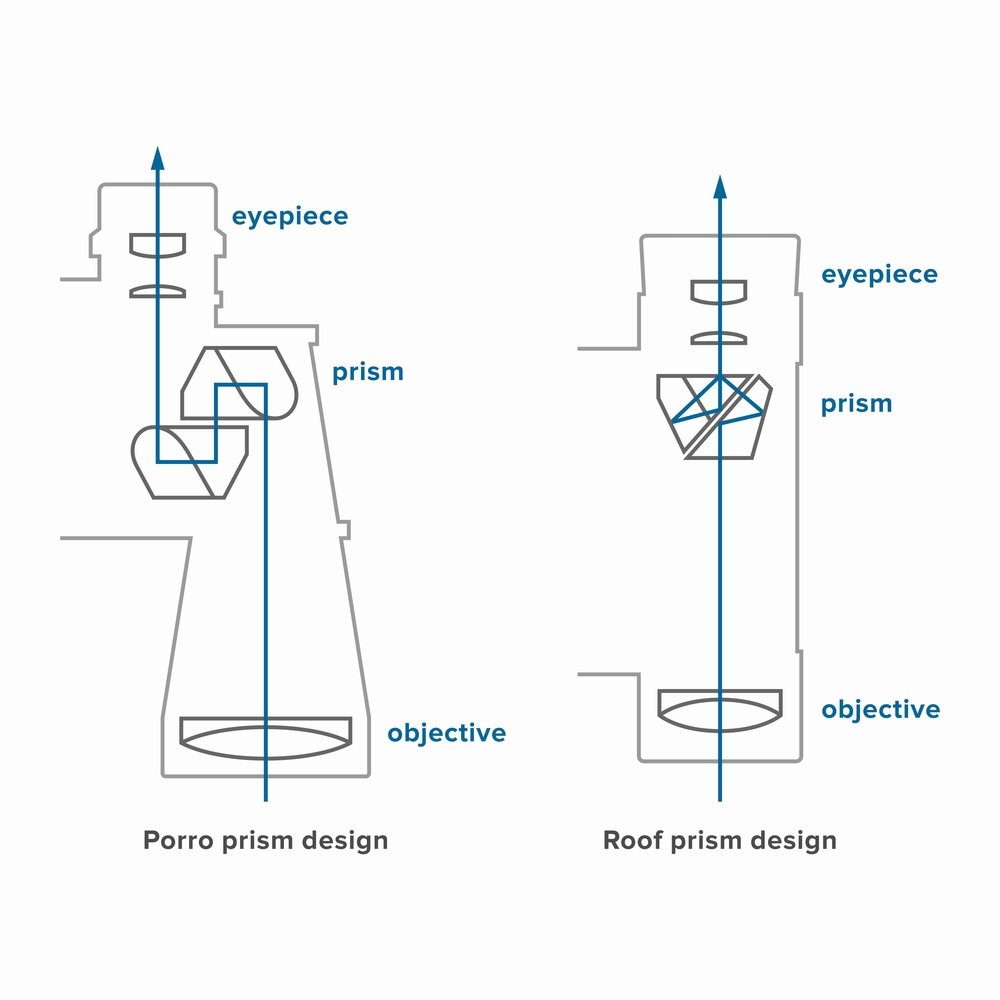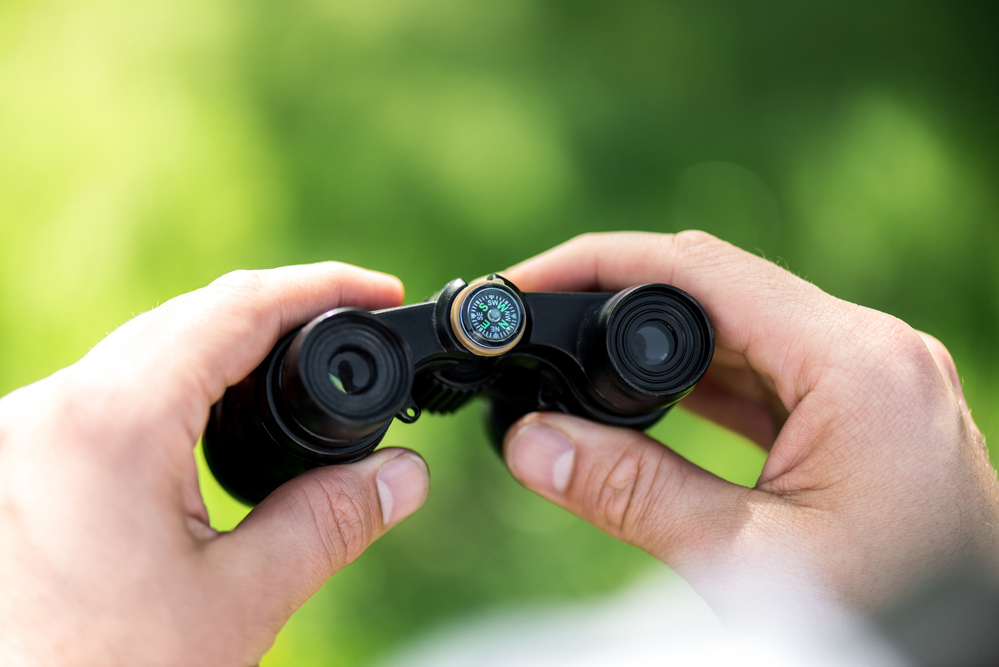Whether it’s for animal or birdwatching, sporting events, or just wanting to get a better look at something, binoculars are the magnifying glass to get closer to the action.
But while we all know that they can bring things visually closer, “how do binoculars work?” is a common question. This article will explain everything you need to know, and when we’re done, you’ll be understanding binoculars like an expert.
From Telescopes to Binoculars
The first optical telescope was conceived in the 17th century. This instrument was only suitable for one eye, but humans have two to see three-dimensional images.
Mounting two telescopes side by side for a better view was unwieldy, but in 1854 the Italian inventor Ignazio Porro patented his Porro prism binoculars which solved the problems of producing a magnified image in the correct view (the right way up and not reversed) inside a relatively compact package.
The Optical Parts of Binoculars
To answer ‘how do binoculars work’, it’s good to start by going through the parts that refract and focus light to enlarge your view.
Remember that binoculars work as two telescopes (oculars). When we talk about the parts that direct and magnify the light for one eye, the same is happening on the other side of the binoculars.
Objective Lenses
The objective lens in binoculars is the largest one and the lens closest to what you are looking at. The objective is a convex lens, thickest at its centre. It is a converging lens, so the light rays coming from the object enter the lens and are brought together. This light concentrates on a focal point.
Binoculars used in low light conditions, such as stargazing, need a large diameter objective lens to gather more light and produce a sharper image.
The Eyepiece Lens
The eyepiece lens is the one closest to you when you’re using the binoculars. This lens receives the light from the objective lens focal length and magnifies it for your eyes to see.
Prisms
You would see the image presented by the objective lens as upside-down without the use of corrective prisms.
Binoculars use a pair of prisms so that you see the magnified image in the correct orientation. Light rays passing through the first prism are rotated through 90-degrees, while the second rotates it a further 90-degrees, so the resulting image is the right way up.
There are two different prism designs used in modern binoculars. The first to be invented was the Porro prism system. This was followed by the roof prism design.
Porro Prism Binoculars
Porro prisms are located horizontally in the binoculars at right angles to each other. This positioning gives a Porro prisms design the classic binocular dog-legged shape where the eyepieces are closer together than the objective lenses.
Roof Prism Binoculars
Roof binocular designs position the prisms one behind the other, so the light path refracts inside them to orient the resulting view correctly. Roof binoculars allow the eyepieces to be in a straight line with the objective lenses.
Comparing the Two Prism Designs

Porro prisms binoculars are said to be cheaper to manufacture compared to roof prism designs. They are usually shorter than an equivalent roof binocular but will typically be bulkier due to the prisms being set side by side. Roof prism binoculars are streamlined in comparison.
Some users consider that Porro prism binoculars are more comfortable in your hands and can give a steadier image. Porro designs tend to have a wider field of vision than roof prisms. However, Porro binoculars may not have such high magnification, thanks to the roof prism’s longer focal path.
Porro binoculars may be more sensitive to knocks and drops, which can move the prisms out of alignment. Users may consider roof binoculars to be more durable in this respect as the prisms are in a straight line and less likely to be affected by impacts.
The Mechanical Parts of Binoculars
In addition to the optical components, most modern binoculars also share a similar set of mechanical parts.
Focus Wheel
On most binoculars, you’ll find the focus wheel between the barrels. You turn it to adjust the focal length on both sides simultaneously until your image is sharp.
Diopter Adjustment
Our eyes are generally not exactly the same strength, so you can use the diopter adjustment ring to compensate and make the image sharp for both eyes.
Hindged Barrel-Bridge
The hinged bridge holds both sides of the binoculars together and lets you adjust their position to fit your eye distance.
Barrel or Tube
The barrel contains all the optical parts and protects them from damage. You’ll often find that binocular barrels are sealed with o-rings to make an airtight seal to prevent dirt or moisture from getting inside. Many modern designs are filled with a gas such as nitrogen and then sealed, which helps keep them clear of condensation and debris for longer.
Binoculars Explained – How They Let You See Far Away Objects
Binoculars use two convex lenses placed one after the other to give you a clearer view of distant objects.
The first convex lens, the larger objective lens, captures the light rays coming from the object and brings them together by refraction at a short focal point to make it seem like you are much closer than you are. The larger the diameter of the objective lens, the larger its aperture and the more light it will gather. Larger lenses will give a sharper or higher resolution image.
The light produced by the convex objective lens is upside down and mirrored. This inverted image is corrected by passing the light through two prisms that turn the light so that the exiting view is the right way up. The first prism inverts the image vertically, and the second prism reverses the image horizontally.
The eyepiece lens works like a magnifying glass and has a focal point that meets that of the objective lens. The eyepiece magnifies the image from the objective so that your eyes can see the distant object close-up.
How are Binoculars Compared?
When comparing binoculars, you’ll see a lot of information that tells you how they work.
Numbers
Binoculars are rated with two numbers, 12 x 25, for example, which tells you the magnification and the size of the objective lens.
Magnification
The first number, called the magnification or power, shows how many times the object you are looking at will be magnified. So for 12 x 25, the item of interest will seem as if it is 12 times closer.
Objective Lens

The second digit refers to the diameter of the objective lenses in millimetres. Remember that the larger the objective lens, the greater the light it can take in, and the higher resolution or sharper the resulting view will be. On the other hand, the larger the objective lens, the bulkier and more expensive the binoculars will be.
Field of View
The field of view gives you the size of the area that you will see. It shows you how many metres across will be visible when looking at something 1,000 metres away. Usually, the higher the magnification, the smaller the field of view.
Eye Relief
Eye relief is the distance you need to hold the binoculars from your eyes so that their entire field of view is visible. This can be an essential consideration if you wear glasses, as you need an eye relief of at least 11mm so that you can hold the binoculars close enough without your glasses coming into contact with the eyepiece lenses.
Exit Pupil
This refers to the width of the light beam coming from the eyepiece. The larger the exit pupil, the brighter the image. The larger the exit pupil, the brighter the image will be. Accordingly, binoculars designed for low-light use will have a large exit pupil so you can see clearly with them.
You can work out the exit pupil for your binoculars by dividing the objective lens diameter by the magnification.
The Different Kinds of Binoculars
While they all work in a very similar way, the right pair of binoculars will depend on what you want to use them for.
- Compact Binoculars – Ideal for taking with you on walks or travels. Lightweight, but probably won’t have the best magnification.
- Midsize Binoculars – Offer a good selection of magnification options without being too large.
- Fullsize Binoculars – Generally chosen for specific applications whose bulk and cost aren’t a problem.
- Foldable and Mini – Very portable, but not very powerful.
- Wide Angle – The largest field of view. Useful for sporting events or spotting animals in a vast space.
- Zoom Binoculars – Allow you to adjust the magnification to choose from a broader or zoomed-in view.
- High Power – Bulky but have extreme magnification and are often used as an alternative to a telescope by astronomers.
- Auto Focus – Have a fixed depth of field to keep everything in focus.
- Image Stabilising – Have built-in systems to reduce image shake.
- Waterproof – Important when you will use the binoculars around water.
Ready to Use Binoculars Like an Expert
As we’ve looked at how do binoculars work, we’ve seen that they can elegantly bring objects closer for you to look at like an advanced magnifying glass.
Binoculars allow you to see further than ever and can improve your enjoyment of sporting events, nature studies, travel and much more.
Additional Resources
- How to Use Binoculars
- What Is the Best Magnification for Bird Watching Binoculars
- How to Clean Binoculars
- When Were Binoculars Invented
- How To Make Binoculars For Kids
Sam loves to learn about animals and their habitats. He has been a nature lover from a very young age, and has been writing papers and articles about wildlife for as long as he can remember.
